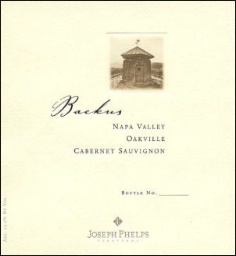
External search
Google (images)
Wine Advocate
Wine Spectator
Burghound
Wine-Searcher
Vintages
2022
2021
2020
2019
2018
2017
2016
2015
2014
2013
2012
2011
2010
2009
2008
2007
2006
2005
2004
2003
Show more
From this producer
Show all wines
All tasting notes
|
| Drinking Windows and Values |
| Drinking window: not specified |
| Community Tasting History |
| Joseph Phelps Producer website
In the late 60s, Joseph Phelps was running one of the largest construction companies in the U.S. when he won the bid to build Souverain Winery (now Rutherford Hill) located a few miles outside of St. Helena. Enamored with the beautiful Napa Valley and contemplating a career change, in 1973 he bought the 600-acre Connolly cattle ranch in Spring Valley, and began planting vineyards. The winery was completed in 1974 and that same year the first Syrah was made, the first grapes were crushed at the new facility and the first Insignia was produced. It was a period of unparalleled activity, creativity, ingenuity, entrepreneurship and risk-taking and it put Joe Phelps on the map of top Napa Valley wine producers.
Nearly four decades later, the flagship wine, Insignia, is recognized as one of the world’s great wines. Twenty nine of 34 vintages have been rated ninety or more points by various wine publications. From 1990 to 2007, the average score from Robert Parker’s Wine Advocate is 94.5 pts., with the lowest score still a fabulous 91. The 2002 vintage was “Wine of the Year” by Wine Spectator Magazine, and the 2007 vintage has been rated 98 points by Robert Parker and 96 points by Wine Spectator Magazine.
Over the years, the goal of becoming 100% estate grown resulted in carefully planned acquisitions of prime vineyards in the Napa Valley. Today, the Phelps estate consists of the Spring Valley Home Ranch outside of St. Helena, Banca Dorada in Rutherford, Las Rocas and Barboza vineyards in Stags Leap, Yountville Vineyard in Oak Knoll, Suscol Vineyard in South Napa and Backus Vineyard in Oakville.
Beginning with the 2009 vintage, estate-grown wines include Cabernet Sauvignon, Sauvignon Blanc, Viognier, Insignia, Backus (the single vineyard Cabernet Sauvignon from Oakville) and Eisrébe, a dessert wine made from the Scheurebe grape. In addition, a small amount of Syrah is produced from fruit owned by Hyde Vineyards in Los Carneros.
Though the main focus is on Bordeaux varietals, Joe Phelps has had a life-long love affair with the wines of Burgundy and a desire to craft wines in that style. Originally Chardonnay was sourced from St. Helena, later from Yountville and then from Los Carneros. Through the years, however, Joe continued to search for the ideal spot to grow both Chardonnay and Pinot Noir, and his search ended when the perfect combination of climate, soil and location was found in Freestone, located in the Sonoma Coast AVA, a mere eight miles from the Pacific Ocean. In 1999, 200 acres were acquired and planting began. Today, 80 acres of Pinot Noir and 20 acres of Chardonnay are producing some remarkable wines which are available for tasting at the Freestone Guest Center. Visit Freestone Vineyards to learn more.Cabernet SauvignonCabernet Sauvignon is probably the most famous red wine grape variety on Earth. It is rivaled in this regard only by its Bordeaux stablemate Merlot, and its opposite number in Burgundy, Pinot Noir. From its origins in Bordeaux, Cabernet has successfully spread to almost every winegrowing country in the world. It is now the key grape variety in many first-rate New World wine regions, most notably Napa Valley, Coonawarra and Maipo Valley. Wherever they come from, Cabernet Sauvignon wines always seem to demonstrate a handful of common character traits: deep color, good tannin structure, moderate acidity and aromas of blackcurrant, tomato leaf, dark spices and cedarwood.
Used as frequently in blends as in varietal wines, Cabernet Sauvignon has a large number of common blending partners. Apart from the obvious Merlot and Cabernet Franc, the most prevalent of these are Malbec, Petit Verdot and Carmenere (the ingredients of a classic Bordeaux Blend), Shiraz (in Australia's favorite blend) and in Spain and South America, a Cabernet – Tempranillo blend is now commonplace. Even the bold Tannat-based wines of Madiran are now generally softened with Cabernet SauvignonUSAAmerican wine has been produced since the 1500s, with the first widespread production beginning in New Mexico in 1628. Today, wine production is undertaken in all fifty states, with California producing 84% of all U.S. wine. The continent of North America is home to several native species of grape, including Vitis labrusca, Vitis riparia, Vitis rotundifolia, and Vitis vulpina, but the wine-making industry is based almost entirely on the cultivation of the European Vitis vinifera, which was introduced by European settlers. With more than 1,100,000 acres (4,500 km2) under vine, the United States is the fourth-largest wine producing country in the world, after Italy, Spain, and France.California2021 vintage: "Unlike almost all other areas of the state, the Russian River Valley had higher than normal crops in 2021, which has made for a wine of greater generosity and fruit forwardness than some of its stablemates." - Morgan Twain-Peterson Napa Valley Napa Valley Wineries and Wine (Napa Valley Vintners)Oakville |
|




